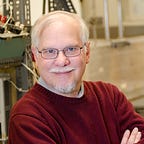The other lesson of Mr. Wizard
On April 14 scientists and their supporters will once again be participating nationwide in the March for Science. Many of those marching will be women, including young girls who aspire to a career in science. The clear lessons are not only that women have always been remarkable scientists, but that girls can envision following them into scientific careers. Amazingly, the latter lesson appeared on television as far back as 1952, on the iconic Watch Mr. Wizard. It is depressing that it is just now starting to really take hold.
As a budding scientist growing up in the 1950’s and 1960’s, the only adult female scientist I was familiar with was Marie Curie. I also owned one of the many chemistry sets that were implicitly or explicitly marketed to boys. The one set promoted to girls, the 1958 Gilbert Lab Technician Set for Girls, gave a clear message of where women fit in the hierarchy of science (i.e., they could only have a subservient role, if that), a view schools and media did little to dispel.
The only place I could see females as equal participants in science was on a television program. In 1952, the pre-teen Susan Levin stepped into the Chicago set of the popular show Watch Mr. Wizard, hosted by “Mr. Wizard” Don Herbert. Until the show was canceled in 1965, girls and boys were given equal time on the program. Of the dozen children who interacted with Mr. Wizard as his “assistants,” five were girls. Pamela Fitzmaurice, Betty Sue Albert, Irene Strom, and Rita McLaughlin followed Susan Levin. In a 2005 interview Herbert stated that girls “got with it” and had more fun than the boys.
Watch Mr. Wizard began in 1951, when television itself was still in its infancy. The program ostensibly took place in Mr. Wizard’s garage or kitchen and the science demonstrated could be done at home, with a minimum of apparatus, much of which was already available or could be easily purchased. As Don Herbert himself put it, “milk bottles are your flasks, glasses your beakers, and the whole house your laboratory.” He deliberately played against stereotypes; he had the girls in the garage and boys in the kitchen. The science kits and books based on the show gave equal prominence to both sexes.
Not surprisingly, given the times, all of the children on Watch Mr. Wizard were white. This changed in his next show. On Mr. Wizard’s World which ran from 1983–1991 on Nickelodeon, Herbert interacted with a far more ethnically and racially diverse group of children. Although the explicit lessons of the Mr. Wizard programs were basic concepts of science, the other, implicit, lesson is that all children should have equal opportunities to learn these ideas.
Despite his promotion of equal participation of boys and girls in science, Herbert was still susceptible to gender-based stereotypes. In a 1957 piece in the New York Herald Tribune, he attacked stereotypical images of scientists (most of which are still around today; just watch The Big Bang Theory). But he ended with “He’s a man — just like other men — working hard at his job.” No mention of women scientists. Marcel Lafollette, in her 2013 book Science on American Television, pointed out that neither Mr. Wizard series included adult woman scientists, a lack it shared with virtually all contemporary television programs.
The last several decades have seen some improvement. As women become an increasing proportion of the scientific community, their portrayal in the media, as both real and fictional individuals has increased. A just published study by David Miller at Northwestern University suggests children’s images of what a scientist looks like is changing in step. Whereas children in the 1960’s and 1970’s nearly universally drew scientists as men, since the 1980’s thirty percent of the pictures have featured women. Lego recently released a“Women of NASA” set, an overdue honor for the accomplishments of a remarkable and diverse group of scientists, mathematicians, and astronauts. The United Nations declared February 11 the International Day of Women and Girls in Science. SciGirls on PBS shows 8–12-year-old girls not only doing interacting with adult female scientists but doing science themselves. A long way to equity, but it is progress.
I cannot imagine doing science without the many brilliant, capable, and tough-minded women that have allowed me to work with them. And I know there are generations of young girls of all backgrounds ready to follow them. You will see them at the April 14 March for Science. Mr. Wizard’s other lesson is finally being learned.
